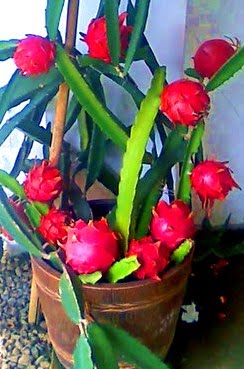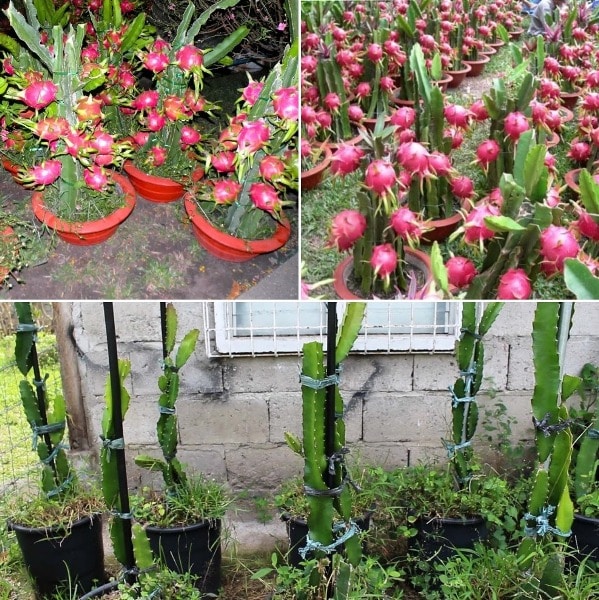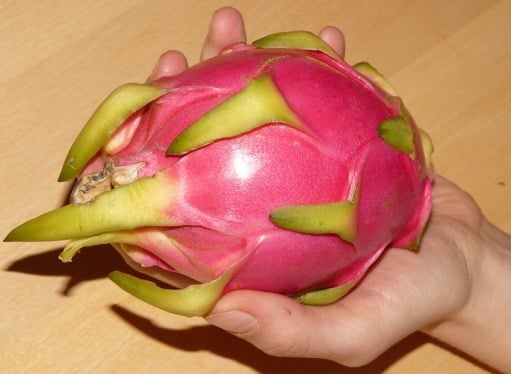Growing Dragon in Pots:
The following information is about Growing Dragon Fruit in Pots.
Introduction To Dragon Fruit
The dragon fruit is commonly known as “Pitaya” or “Pitahaya” a fruit from cactus species. Dragon fruit refers to the fruit of the genus Hylocereucs. Dragon fruits are native to Mexico, Costa Rica, and El Salvador. Dragon fruits are cultivated in tropical and subtropical regions. the dragon fruit plant is a climbing plant, that needs to support to climb. When the plant matures, if forms aerial roots from the branches of plants so they need support to grow. The dragon fruit plant loves heat and it thrives well in dry areas with partial sun. the flowers of plants are unique, flower is large, and blooms open only at night and expels an amazing scent that at night. Dragon fruit plants not only produces delicious fruits, but they are also the best ornamental plants. Dragon fruits are used in jams, ice creams, fruit juice, and wine.
The dragon fruits come in dark red color, pink or yellow colors. These fruits have very thin skin covered with scales with a tasty red or white pulp in the center made of fruit. Dragon fruits can be grown from seeds or cuttings or by purchasing a potted plant. Let us discuss more Growing Dragon Fruit in upcoming sections of this content.
- Scientific Name for Dragon Fruit: HylocereusUndatus (White fleshed Dragon Fruit/White Pithaya), HylocereusCostaricensis (Red-fleshed Dragon Fruit, Red-fleshed Pitaya), HylocereusMegalanthus (yellow Pitaya, yellow dragon fruit).
- Family: Dragon Fruit belongs to family Cactus.
- Common Names: Pitaya, Strawberry Pear, Belle of the Night, Nanettika Fruit, Cactus Fruit, Night Blooming Cereus.
Varieties for Growing Dragon Fruit in Pots
Dragon fruits are of two varieties Stenocereus (sour dragon fruits/sour pitaya) and Hylocereus (sweet dragon fruit or sweet pitaya)
- Stenocereus: these dragon fruits are common fruits in areas of the USA, these have a sour and refreshing taste
- Dragon Fruit Hylocereus: These dragon fruits are sweet fruits comes in different colors. There are three types of sweet dragon fruits.
- White-fleshed Dragon Fruits or Pitaya Blanca or HylocereusUndatus: these fruits have pink-skinned fruit with white flesh, these are most commonly seen dragon fruits.
- Red-Fleshed Dragon Fruits or Pitaya Rosa or HylocereusPolyrhizus: these fruits have red skin with red flesh.
- Yellow Pitaya/ Yellow Amarilla or SelenicereusMegalanthus or HylocereusMegalanthus: these fruits have yellow-skinned fruit with white flesh.

Suitable Pots for Growing Dragon Fruit in Pots
- The Ideal size of the pot is 15-24 inches in diameter and 10-12 inches in depth.
- Pots should have a good draining system. Pots should have 2 to 3 drain holes.
- Use plastic pots, clay pots, terracotta pots, up drums or cans for growing dragon fruits.
- For healthy growth of the plant use pots made of clay that keeps the temperature of the plant.
- Bigger the size of the pot, better the growth of dragon fruit.
Ideal Season for Growing Dragon Fruit in Pots

- Dragon fruit loves to grow in a tropical climate can also be grown in sub-tropical climates.
- Accept freezing winters, dragon fruits can be planted in spring, fall and summer season.
- Ideal temperature should be 20 to 30 degrees.
- It thrives well in dry and wet climates.
- The dragon fruit plant can survive short periods of freezing temperatures and frost. But may spoil in longer periods of frost.
Suitable Soil for Growing Dragon Fruit in Pots
- The dragon fruits grow in well-drained fertile soil.
- Soil using should very sandy if using garden soil or poor soil, add some quality river sand to increase its draining capacity.
- It is recommended to use cactus mix is a good growing medium for growing cactus family plants. Cactus potting soils are available in the nurseries, garden centers or online.
- If the cactus potting mix is not available to use a good quality potting mix with sand or perlite, organic manure, and compost in the ration of 2:3:1:1.
- Mix all the ingredients thoroughly and fill the container with potting soil allow to stay overnight before planting.
Read:Harvesting Techniques of Fruits and Vegetables.
Propagating Methods for Growing Dragon Fruit in Pots
the dragon fruits can be propagated by seeds and cutting or buying potted plants from nurseries. Propagating the dragon fruits is easy and grow very fast. Buying potted plants are mostly recommended. Growing dragon fruit plants from seeds is a time taking process.
Growing Dragon Fruit in Pots from Seeds
- Dragon fruit seeds can be purchased from the local markets or can be collected from fresh fruits.
- For collecting the seeds from fresh fruits, cut dragon fruit and scoop out seeds from the pulp. Wash the seeds and wrap them in a paper towel. And dry them overnight.
- For sowing seeds, use seed starting mix and seedling tray.
- Seed starting mix can be peat + Perlite in 1:1 ration.
- Fill the seedling tray or seedling pots with the potting soil.
- Sprinkle the seeds over the surface of the soil and cover the seeds with a thin layer of the potting soil.
- Keep the soil moist constantly and cover the pot with a plastic wrap.
- Seeds take 15 to 30 days to germinate.
- After germinating, remove the plastic wrap and transplant into the desired pot and place it in a warm location with partial shade.
- Once the seedling starts growing, insert steel for support and tie the branches to the rod with wires.
- Water regularly and feed the plants with balanced fertilizer regularly.
Growing Dragon Fruit in Pots from Cuttings

- Growing dragon fruits from cutting are the best and easy method for propagating.
- Stems should be cut properly from a healthy plant. Use a sharp knife to cut the cutting from the plant.
- Length of the cutting should be 6 to 16 inches, collected from the plant that produces fruit.
- Cutting should be collected only in the early morning.
- Immerse the cuttings in a liquid fungicide for a few seconds and dry it.
- Now place the cuttings in a shady and cool location with good circulation for 5 to 6 days, this increases the disease resistance in cuttings and fastens the growth.
- Now fill the container with potting mix to a half and place the climbing pole and fill the pot. Now plant the cuttings about 3-5 inches deep beside the rods and tie with wire loosely.
- Keep the soil moist and place the pot in a sunny location.
- Dragon fruit cuttings take 5 to 7 weeks to germinate depending on stem cuttings and climatic conditions.
- Once the cutting become firm and form a root system, feed the plant with balanced organic liquid fertilizer.
Watering Requirements for Growing Dragon Fruit in Pots
- The dragon fruit plant doesn’t require flooding water. Overwatering can cause rotting in the plants.
- Keep the potting mix moist constantly.
- Once the dragon fruit plant climbs the poles, keeping the pole moist is recommended.
- The dragon fruit plant can tolerate severe drought conditions for a long period.
Sunlight Requirement for Growing Dragon Fruit in Pots
- Dragon fruits love sunlight.
- Thrives well in partial to full sun.
- These plants can also be grown in bright shade areas.
- The leaves of the dragon fruits should be exposed to sunlight for fast growing.
- The dragon fruit plant requires 6 to 7 hours of sunlight per day.
- Adequate sunlight fastens the growth of the plant and increases blooms and fruiting.
Suitable Location for Growing Dragon Fruit in Pots
- Dragons fruits grow in warm, dry and humid areas.
- So, the place the container where it gets a good amount of light and air.
- The terrace gardens, balconies, backyards, front yards, and outdoor gardens.
- Dragon fruits can be grown in indoor where it can good amount of light and air, the window sill is the ideal location for indoor gardening.
Pruning Requirement for Growing Dragon Fruit in pots
- Pruning the done to maintain the compact size of the plant, for growing dragon fruits in pots pruning is a compulsory act.
- The Dragon fruit plant can grow up to 20 feet height, but if you want to keep it in a preferred height, just prune the branches.
- Keeping the plant compact can make the plant stronger and increases the yields.
Pollination Requirement for Growing Dragon Fruit in Pots
- Pollination in plants increases the fruits. But most of the varieties of dragon fruit plants are self-pollinating only some varieties need cross-pollination.
- Moths, bats, and bees pollinate the dragon fruit plant, or hand pollination can also be the best option for home gardening.
- For hand pollination, collect the pollen for other dragon fruit plant using a cotton swab or smooth brush and then rub the pollen on the stigma of your plant.
- Hand pollination should be done during the night or early in the morning.
- If your plant is flowering and unable to bear fruit this indicates that it is not self-pollinating. Do hand pollination to increase yield.
Fertilizers for Growing Dragon Fruit in Pots
- If your growing dragon fruits from seeds, start feeding plant when it reaches 4 to 5 inches height.
- If your growing dragon fruits from cuttings, start feeding the plant after 6 to 7 months. A dragon fruit cutting takes a minimum of 5 months to form a complete root system.
- Feed the plants with slow-release fertilizers with low nitrogen levels once in two months.
- Can use all-purpose commercial fertilizer for feeding, using an organic fertilizer with low nitrogen levels is recommended.
- If using Organic fertilizer, they should be applied once in 3 months.
- To increase the fruit production: feed the plants with Urea, Phosphate, Potassium in a ratio of 1:1:2 before the flowering season and after the harvesting seasons.
- Over-fertilizing can harm the growth of the plant.
Pests and Diseases in Growing Dragon Fruit in Pots
- Common pests that trouble dragon fruit plants are mealybug and aphids. These insects suck the sweet sap of the plant and will spoil the growth.
- Ants are also a major problem; the ants will run upon the plant and sucks the sap.
- Plants are also affected by spider mites and thrips, these can slow the growth of the plant.
- Use Neem oil or Horticultural oil spray or mild soapy water spray can treat these pests. Don’t use commercial organic pesticides to treat pests.
- Diseases that affect dragon fruit are Dragon Spots, these spots occur on the stems and leaves of the plant due to bacteria. This disease can spread easily from plant to plant.
- Use an organic fungicide to treat diseases in dragon fruits. Using commercial potting mixes and watering at the base of the plant without making branches wet can control fungal and bacterial diseases.
- The Plant can be affected with sunburns during the hottest time of the summer season when the sun is sweltering hot.
- And the plant suffers from rot due to overwatering. Using well-drained soils can protect the plants from rotting.
Harvesting Tips for Growing Dragon Fruit in Pots
- The Dragon fruit plant grown from seeds takes 5 to 6 years for producing fruits.
- The Dragon fruit plant grown from cutting takes 3 to 4 years for producing fruits.
- The Dragon fruit plant bears fruit for five months every year. The plant blooms in early summer (mainly in June). The flowers first form some small buds within 13 days for their formation. And these buds transform into fruits after the flowering and pollination occur. The dragon fruit plant produces flowers throughout the fruit-bearing seasons.
- The plant bears fruit from the end of July to the end of November. Fruits can be harvested five to six times during the fruit-bearing season.
- A dragon fruit plant can produce fruit up to 20 to 30 years.
- The plant produces fruit after 30 to 50 days of flowering.
- Pick the fruits when the color of fruit changes from green to red or pink or yellow depending on the variety. It is better to harvest after four days of color changing.
- Or if you are planning export or planning to for a long period, pick them on the next day after of color changing.
Quick Tips for Growing Dragon Fruit in Pots

- Warm and dry weather with moist soil can increase the fruiting period of the dragon fruit plant.
- At a constant temperature of 26 degrees, the dragon fruit plant can produce early flowers and fruits beyond the normal bearing season.
- A long period of cool climates can shorten the fruit-bearing period of the plant.
- Good watering frequencies will produce more juicy and tasty fruits during fruit bearing seasons.
- The dragon fruit belongs to the cactus family, and these family plants need water and fertilizer for proper growth. Use organic or inorganic fertilizer at a specified time and in a specified amount
- The dragon fruit plant needs support to climb, use wooden or concrete poles for support.
- 10 to 30% sandy soils rich in organic matter provide a best-growing medium for the dragon fruit plants.
- Give a minimum of 1-inch water per week for the healthy growth of the plant.
- Harvesting the stem cuttings every year will keep the plant growth under control, maintaining the compact size of the plant will make the plant stronger with more fruits.
- Hot summers are ideal growing seasons for dragon fruit plant, feed the plant once in a month with natural or organic fertilizers during the summer season to fasten the growth. It is recommended to use fertilizers with low nitrogen levels for the cactus plants.
- The dragon fruit plant can be planted any time of year. As the dragon fruit plant is a self-established can survive at any time.
- During the very cold climates, the plant should be protected from freezing temperatures cover the plant with garden cloches or moving it to warm areas like the garage, greenhouses or indoor where the climate is warm.
- The Dragon fruit plants are not only grown for fruits, but many people also grew them as ornamental purposes. As the flowers of the plant are incredible.
I would like to plant dragon fruit , Litchi,strawberry tree
i would like to buy fruit plant like strawberry tree,Cherry, Lychi
The information furnished by your site is extremely useful. Thanks.
Requir the dragon fruit plant red pulp plant is available in Delhi, India